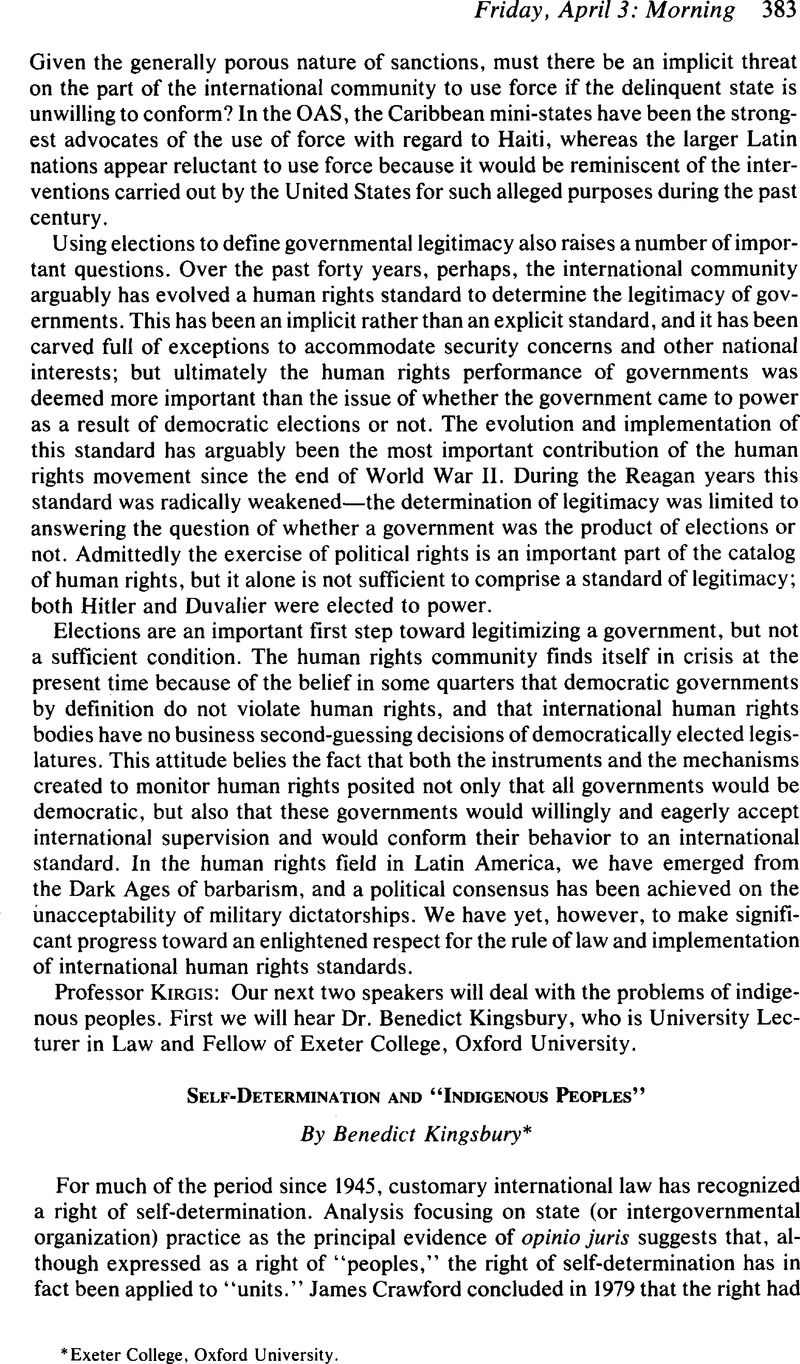Published online by Cambridge University Press: 28 February 2017

1 James Crawford, The Creation Of States In International Law 84-102 (1979). Recent practice concerning the recognition as independent states of various of the highest-level constituent republics of the USSR and Yugoslavia suggests that additional categories of unit may be emerging. These might tentatively be identified as: (5) highest level constituent units of a federal state that has been (or is in the process of being) dissolved by agreement among all (or, in the case of Yugoslavia, most) of the constituent units; and possibly (6) formerly independent entities reasserting their independence with at least the tacit consent of the established state where incorporation into the other state, although effective and enduring de facto, was illegal or of dubious legality. (It is not clear that the independence and recognition of the three Baltic states in fact provides a basis for the elaboration of such an additional category—this topic is too complex to explore here.)
The continuing developments in the territory formerly covered by the Soviet and Yugoslav federations, and the evolution of other cases such as those of Czechoslovakia and Ethiopia, may provide further material for the consolidation, analytical refinement, and conceivably even the extension of this list in the near future. Any such list is bound to be merely indicative; new cases are likely to stretch, bridge or cut across the categories. Because of uncertainty as to their precedential scope and their conjectural nature to date, these categories will not be discussed further here.
2 After Lung-chu Chen, Self-Determination as a Human Right, in W. Michael Reisman & Burns Weston (Eds.), Toward World Order And Human Dignity: Essays In Honor Of Myres S. Mcdougal 186, 206-07 (1976). Categories 1(b), 2(c) and 3 have been added. See also Francesco Capotorti, The International Measures of Implementation Included in the Covenants on Human Rights, in Asbjørn Eide & August Schou (Eds.), International Protection Of Human Rights 283-84 (1968).
3 For a more extensive discussion of relevant international practice, see generally Benedict Kingsbury, “Indigenous Peoples” as an International Legal Concept, in R. H. Barnes Et Al. (Eds.), Indigenous Peoples In Asia (Forthcoming).
4 UN Doc. E/CN.4/Sub.2/1986/7/Add.4, ¶378. For the working definition used during the study, see UN Doc. E/CN.4/Sub.2/L.566, ¶¶24-45.
5 Id. at ¶¶79-80. This definition, like much of the report, was drafted by Mr. A. Willemsen-Diaz, then with the UN Secretariat and subsequently Chairman of the Board of Trustees of the UN Voluntary Fund for Indigenous Populations. In its annual “review of developments,” and in seeking to draft a Universal Declaration on the Rights of Indigenous Peoples, the UN Working Group on Indigenous Populations has expressed a degree of satisfaction with this definition but has not itself sought to elaborate definitional criteria.
6 See, e.g., A. H. Snow, The Question Of Aborigines In The Law And Practice Of Nations (1920).
07 One version of the makarrata proposal in Australia, for example, involves a treaty or compact between Australia and aboriginal people with a UN supervisory role. Invitations instigated by indigenous groups to (1) the UN Working Group on Indigenous Populations (particularly to the Chairperson- Rapporteur) and (2) the Special Rapporteur on Treaties and Other Constructive Arrangements to visit their territories are in some respects reminiscent of missions dispatched by the Special Committee on Decolonization and, in tandem with the Working Groups’ annual meetings, have often been quite effective in promoting accountability and dialogue.
08 The Right to Self-Determination: Implementation of United Nations Resolutions, UN Doc. E/CN.4/Sub.2/405/Rev.l (1980).
09 9See, e.g., GA Res. 44/128 (Jan. 30, 1989), reprinted in 29 ILM 1464 (1990).
10 UN Doc. E/CN.4/Sub.2/40 (1991), p. 32.
11 See, e.g., Ian Brownlie, The Rights of Peoples in Modern International Law, in James Crawford (ED.), The Rights Of Peoples 6 (1988). See Also Hurst Hannum, Autonomy, Sovereignty, And Self-Determination 473-77 (1990) and Giorgio Sacerdoti, New Developments in Group Consciousness and the International Protection of the Rights of Minorities, 13 ISRAEL Y.B. HUM. RTS. 116 (1983). Georges Scelle had taken a similar position in the 1930s, in Le régime minoritaire est, avons-nous dit, un succédané du droit des peuples a disposer d’eux-mémes, Précis Du Droit Des Gens, Vol. 2, 258 (1936).
12 See Generally, E.G., Fernand Braudel, Civilisation Materielle, Economie Et Capitalisme, Xve-Xviie Siecle, 2D Ed., (1980).
13 Arguments of this sort have generated a longstanding mistrust about nationalism and national selfdetermination within the tradition of liberalism. As Neil MacCormick notes: “From Hitler to Ceausescu, there has been no shortage of illustrative evils showing how the pursuit of national liberty and national values can lead to denigration, servility, torture and death for those out[side] the charmed national circle, and even for many within it."” Neil MacCormick, Is Nationalism Philosophically Credible,“! in William Twining (Ed.). Issues Of Self-Determination (1991), at 10-11.
14 See Avishai Margalit & Joseph Raz, National Self-Determination, 87 J. Phil. 439-61 (1990); See Generally Joseph Raz, The Morality Of Freedom, esp. 207-13 (1986).
15 This involves a rejection of methodological individualism
16 Margalit & Raz, supra note 14, at 440.